ENERGY SYNTHESIS IS A THEORY DEVELOPED BY ALFRED WAKEMAN WHICH DESCRIBES NATURE IN TERMS OF TOROIDAL VORTEX FLOWS. THE THEORY IS BASED ON FINDINGS FROM YEARS OF STUDYING FLUID FLOWS, BOTH FROM AN EXPERIMENTAL AND A PHILOSOPHICAL PERSPECTIVE. HE ELABORATES UPON MANY DETAILS REQUIRED FOR THE GROWTH AND SUSTAINABILITY OF PHYSICAL FORMS FROM ATOMS TO GALAXIES. THIS ARTICLE PRESENTS ONLY BRIEF EXCERPTS FROM HIS WORK.
by Alfred Wakeman
Physics now recognizes self-organization, increasing returns, and systems that never come to rest in nature. While fundamental to biology, the evidence contradicts classical assumptions. Investigating these phenomena, by the mid-198os, a new interdisciplinary science began to take shape, identified variously by key words such as nonlinear dynamics, complexity, and far from equilibrium systems. Energy synthesis (ES) theory fits within this new realm of study. A practical culmination of this theory is the proposed apparatus shown in Fig. 1. It consists of a symmetrical set of chambers in which flow resonances may be generated to ever-increasing energy levels.
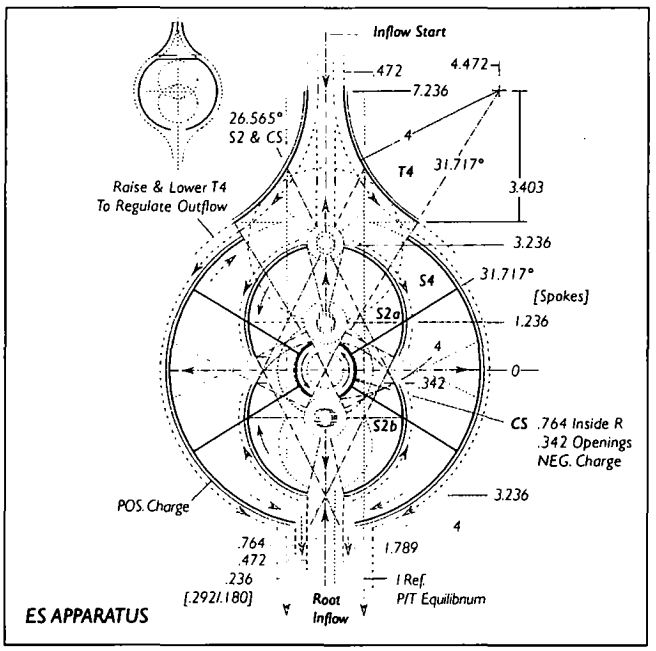
Figure 1: A resonating energy chamber designed for ES experiments.
Energy synthesis theory began in 1975 when I noticed toroidal recirculation underlying all sustainable evolution, from a vortex in water to growth of a plant, from storms to solar systems to spiral galaxies. Within this view of nature, we find that the entire universe down to its least atom exists in perpetual motion, revealing repeating patterns of underlying fluid dynamics. Presumably, then, if an atom is a fluid dynamic phenomenon, and if we can discover the flow topology preserving an atom, we will have a universal model for understanding sustainable existence at any level of complexity. My investigation reveals that a process of inverse entropy, or energy synthesis, may be taking place as the sustaining source of an atom’s energy.
A PRELIMINARY VIEW OF ENERGY SYNTHESIS
Look to the simplest forms of nature’s self-organization which are found in fluid motion’s response to stress and its method of release. (See Fig. 2.)

Figure 2: Orders of Turbulence (volume-rate transactions)
The result is spin, 90° to tension, preserving the axis of tension. Ninety degrees to any stream of motion, tension is created. Attempts to break this tension result in a bias toward recirculation in place. This phenomenon is found at every scale, from the behavior of water and air to the birth and evolution of galaxies. Reduced to essence, two forms of recirculation dominate nature’s evolution: vortex spin and toroidal recirculation. (See Fig. 2 and Fig. 3.) Of these, toroidal recirculation underlies every form of sustainable evolution, including vortex formation.

The recirculations within an ordinary disturbed fluid have a three-dimensional aspect which tends to resolve into two fundamental forms of motion: rotary, as whirlpools of diminishing scale; and toroidal, like smoke rings, increasing in scale. Both increase their rates of characteristic motion toward a tensioned axis. The vortex increases its maximum rotational rate along a linear axis; the toroid condenses its maximum rotational rate around a circular axis, as illustrated in Fig. 4. Both, nested together about a common vertical axis, are goo reflections of each other.
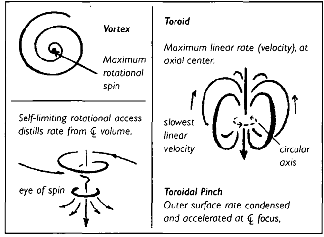
These characteristics are perhaps best illustrated by weather systems. A hurricane demonstrates vortex dominance, and a tornado or water spout demonstrates toroidal recirculation. Each must display a degree of the other’s recirculatory nature to remain self-sustaining. Fully rotational or fully toroidal, either process quickly decays. (See Fig. 5 and the “Spirals” popup.)
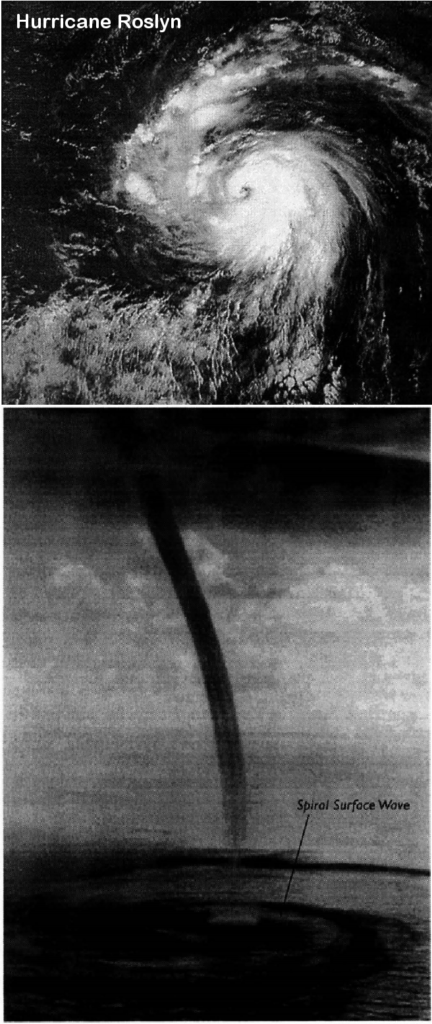
THE VORTEX – ENERGY GAIN AND LOSS
It is important to make the distinction between fluid vortex spin and solid-body spin. For this picture, consider a constant linear rate spiraling inward. To conserve angular momentum, spin accelerates as the radius of spin diminishes. As the zero axis is approached, spin rate approaches infinity and breaks outward, creating an open eye.
Alternatively, if the rotational rate of the eye is held constant, as with solid-body spin, linear rate at the center of the eye becomes zero but approaches infinity as the radius of spin increases, creating outward tension. A vortex cycles toward equilibrium between these opposite effects. Viscosity determines the bias toward solid body spin, while fluidity determines the bias toward vortex spin. Consider the potential, then, of a superfluid medium, having zero viscosity and zero resistance to energy gain, as the radius of spin about its axis condenses toward zero.
In a water vortex, picture a drain creating an axis of tension goo to the top surface. Material attracted to the drain exceeds outflow opportunity, and the excess material set in motion organizes as upward spin released at the head. At the spiraling head, centrifugal outflow resists outflow from the drain. As drain outflow diminishes, centrifugal resistance diminishes, drain outflow increases, and centripetal spin increases. Fig. 6 diagrams some of these relationships. The process cycles toward lateral/axial equilibrium. A vortex formed over an open drain has limited spin because the open drain releases tension upward as spin increases. It takes very little gravitational bias to set a large body of material in motion.
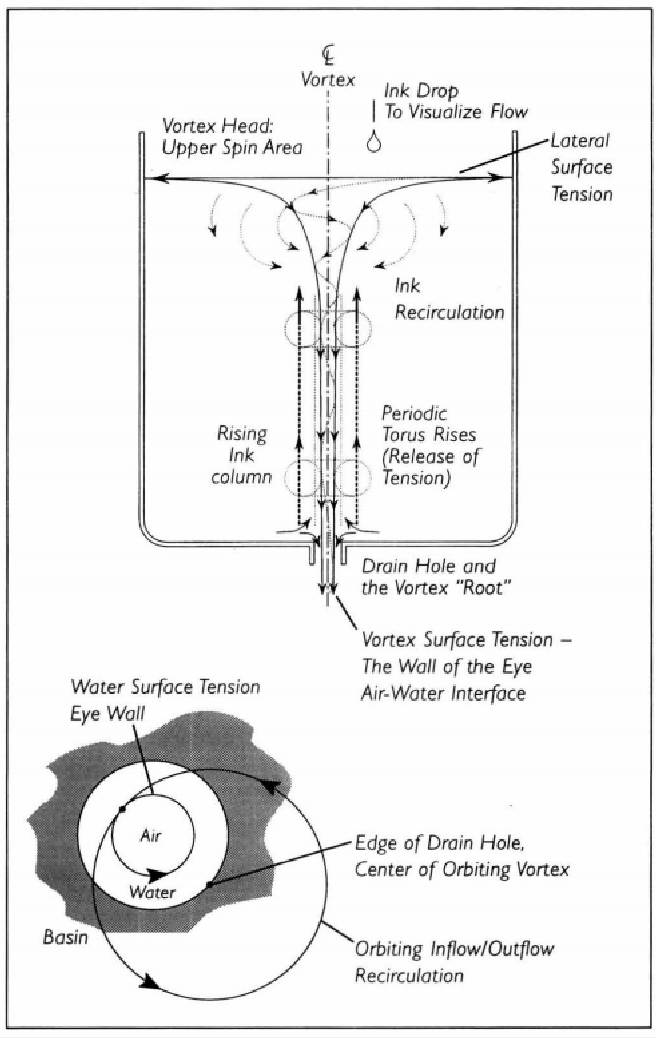
In a vortex, as the volume of spinning material increases, lateral outward tension increases, increasing inward spin toward potentially unlimited heat distillation and energy gain. But to achieve this potential, there must be no possible release of the root-preserving axial tension. Theoretically, the tornado’s demise is not through diffusion, but through a loss of balance between two opposing processes to a point where energy gain is insufficient to cover energy loss.
Even within the stream, on closer inspection, we find spiraling outflow returned to inflow. Nothing exists without inflow and outflow. What is allowed in and what is thereby displaced outward determines the nature of the form of existence. Without a continuing process of distillation for inflow, the seed, or what ultimately grows from it, disintegrates, and ceases to exist.
TENSION / RELEASE
A difficult experiment performed in Germany, requires a very stable water vortex within undisturbed surroundings. As the extended open eye of the vortex gradually increases its surface tension, a periodic release of tension forms a torus climbing the column from root to head. (See Fig. 6.)
By adding ink to a water vortex, one can observe a cohesive, well-defined cylindrical ink column surrounding the eye, rising upward contrary to expectations. (See Fig. 6 and Fig. 7.) The result provides a very convincing laboratory picture of the ink column of a tornado.
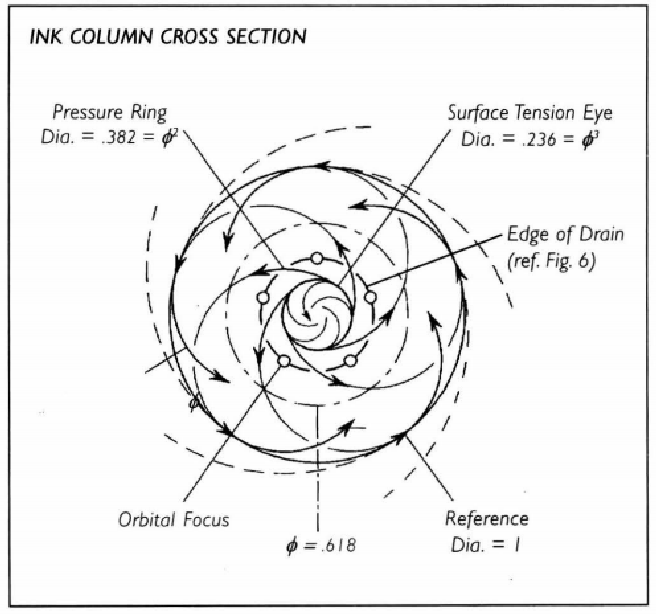
A sustainable process requires inflow/outflow equilibrium. In Fig. 7, defining the orbital cross section of an ink column, if you draw the orbital recirculation outward, the eye spins faster, drawing orbital spin inward, expanding the eye. The eye of a vortex is cold, serving as a heat attractor, allowing cold spin acceleration, attracting heat for continued energy gain. The drawing describes the harmonic equilibrium of the phenomenon governing the axially-tensioned geometries described by ES theory. The water spout photo (Fig. 5) shows many of the characteristics described.
According to ES theory, this ink column is composed of sticky ions, molecules from which the outer recirculation has been removed by spin pressure and shear, making them cohesive. Any process attempting to extract electricity from atoms will run into this sticky ion problem, increasing resistance to further release of electricity. But in a fluid medium, which ES requires, these sticky ions have mobility. They can be continually displaced and replaced and easily stripped of their outermost material as they pass through.
In another experiment performed in Germany, a smoke ring consistently condensed and accelerated over 20 meters to blow out a candle. As everyone knows, a smoke ring normally slows, expands, and dissipates into leftover lateral spin. The described experiment required a humid atmosphere within an auditorium at a temperature above J0°C. A clear smoke ring sent through a cloud of smoke will come out the other side full of smoke. Toroidal recirculation is an accumulator, and similar to an axial vortex, heat gravitates to the now outward circular ring of toroidal spin. The heat gravitation normally allows expansion and dissipation of the ring, but under special circumstances, with linear acceleration preserving toroidal spin, attraction of heat to the eye-ring allows continual release of material into the wake of progress, preserving linear acceleration. The result of toroidal spin is tension ahead and release behind.
THE TOROIDAL VORTEX (see popup)
No formation of a vortex is possible without some form of outflow returned to inflow. A vortex can exist only within a larger toroidal recirculation, with outflow from the root and inflow to the head. Thus, according to ES theory and experiment, toroidal recirculation is primary, and vortex spin is secondary. (See Fig. 8 and Fig. 9) All forms of recirculation are allowed by the instability and fluidity of nature’s underlying medium. The varied forms are sustainable only through a combination of the two self-ordering circulations.
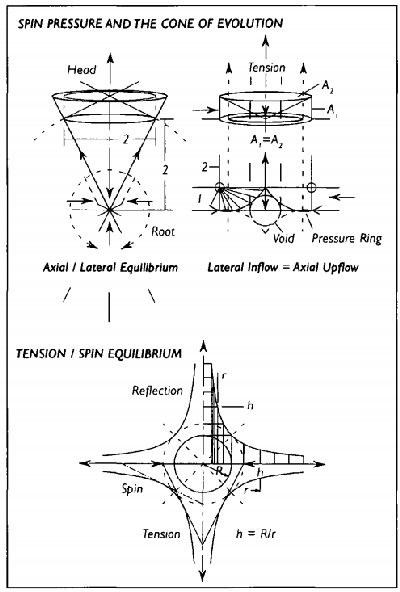

It is worth noting that a critical instability exists between vortex rotation and toroidal dominance of such systems. Internally, vortex and toroidal recirculations each contain elements of the other’s existence, but if either form dominates the resolution, it limits their lifetimes. In a specific form of cooperation, however, an infinitely sustainable storm is born, which reduces in scale as it intensifies toward almost limitless, stress-free acceleration. The storm, as any form of existence, is self-defended by the form of its recirculation. Every self-balancing mechanism in nature cycles around opposites, one dominant, the other its reflection. They must have a built-in process of self-defeat for regulation, on which the continuation of their existence depends.
THE BIPOLAR TOROIDAL VORTEX (see popup)
Exploring the possibilities of an absolutely unstable medium, a certain form of flow, with a potential for reciprocal energy gain, becomes very fascinating. I call it the bipolar toroidal vortex. In weather systems, it is represented by the tornado, where tension both upward and downward from the equator doubles the spin potential.
A tornado can be visualized as a bipolar vortex with the surface at the equator of spin and having drains both upward and downward. If outflow is returned from the drains to the equator, the result would be a relatively self-contained sphere of recirculation. If the tornadic bipolar vortex is turned inside out, there will be a common drain at the center with out-spin from opposite heads, rather than from the drains, returned to the equator. Now, any attempt to release the drain, sustaining spin in one hemisphere, accelerates spin in the other, and the reciprocating drain will be captured at the center for unlimited spin acceleration. Note the essential reflection requiring a duality rather than a singularity. This is similar to describing an electron configuration with the atomic proton existing as an inversion at the center.
THE E-MEDIUM
The atomic aspects of ES theory require the visualization of an absolutely fluid and universal medium (see popup) with zero mass or inertia, zero resistance to motion in any direction, while being absolutely incapable of compression or a void in its existence. Nothing can move outward without something moving inward; nothing can move inward without something moving outward. Call this medium the e-medium, fully capable of physically displacing atoms, which exist only as forms of turbulence within the medium.
Within ES theory, nothing can be expressed as known or recognized without translation into some form of motion and its effect. Mass, inertia, lift and drag, electrons, neutrons, quarks and gluons, heat energy, all must be visualized in terms of various forms of motion and recirculations and their effect within the e-medium to be relevant to ES theory. The problem is that any motion creates stress and any motion to relieve the stress creates potentially infinite stress 90° to the motion, preserving the stress.
We now have a basic picture of an underlying fluid medium subject to recirculation in place. But if recirculation is essentially spherical, demanding inflow/outflow of the surrounding medium to exist, there will always be free flow of material between the spheres. The intermediate medium, regardless of the geometry of atomic form, remains subject to chaos. In ES theory, this chaos is called heat, but under tension, precisely the same medium becomes cold electrical tension. Heat and electricity are thus seen as the same thing in different form, differentiated by relative pressure or tension. The universal fluid medium of both is called the e-medium, within which atoms exist as specialized forms of spin.
THE ATOM
Turbulence is cohesive. Atoms are cohesive. On close inspection, turbulence is composed of self-organizing, if very short-lived, interacting toroidal and vortex recirculations. Absolute chaos within a subatomic fluid medium may well contain the seeds of atomic origin. A smoke ring is relatively self-sustaining. So is a tornado. Each is self-organizing, and each contains elements of the other in its manner of existence. The two circulations have limited lifetimes, but, in a specific topology of toroidal vortex recirculation, plus inflow and outflow, they become mutually self-sustaining. In ES theory, the atomic proton exists as a continually self-preserving storm of recirculations within a fluid medium.
Outflow returned to inflow, sustaining the proton, forms an outer sphere of recirculation where a vortex forms regulating the proton’s energy gain. The outer sphere of recirculation, governing the proton’s existence, is a critical discovery of ES theory. It serves as a universal model for all self-limiting phenomena. It regulates overpopulation, where the destructive effect returns to limit the source. A system where outflow/inflow works in cooperation with its environment results in energy gain throughout the system.
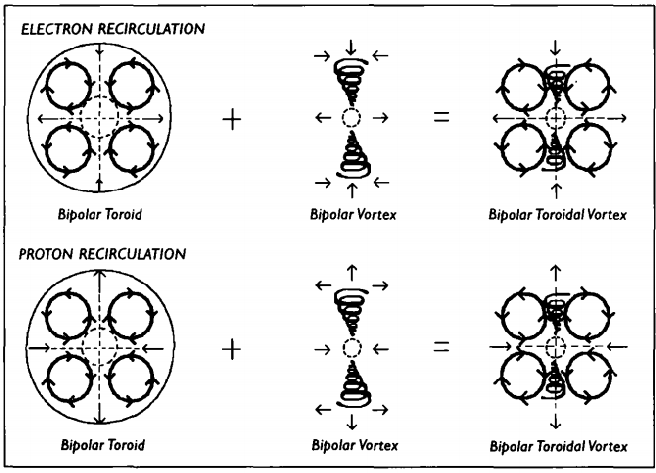
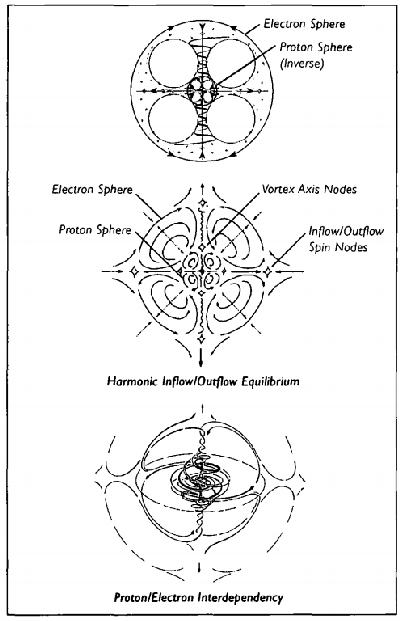
As a symmetrical model, the electron recirculation shown in Fig. 10 and Fig. 11 represents the outer recirculation of the helium atom, the solar system, or a spiral galaxy. The hydrogen atom is axially asymmetrical. Perfect symmetry with a single proton is impossible to maintain. The result is a bias toward outflow from one pole returned to inflow at the other. This results in the single electron, the vortex head observed by science, of the hydrogen atom. (See Fig. 12.)

Note that the polarity is reversible. Superior tension at the opposite pole can reverse the bias causing release of a previous bond. It is this that preserves the fluidity of water and cohesion at the surface.

The most recent depiction of the proton/electron interdependency is revealed in Fig. 13, which shows the nuclear and electron circulations. The electron reflection, generated by the existence of proton flow recirculation, is called the electron sphere of recirculation. The combination, a unity of cause and effect recirculated, is the hydrogen atom. This is why the proton and electron do not exist as separate entities.
Any process of existence capable of indefinite survival will have a proton-form energy source and an electron form of self-regulation. Regardless of the apparent topological complexity, this essence will be dominant. The form will otherwise be self-defeating.
What is important to recognize at the atomic level is tension radiating 90° to any flow. Visualizing the proton as a spherical recirculation, the effect is gravitation proton-to-proton, capable of crystallizing protons into complex elements. Then, complex electron recirculations can crystallize into complex molecules. At the nuclear level, sustainable combinations are limited. At the electron level, sustainable combinations are almost unlimited. At the make/ break level, the interactions are unlimited.
CONCLUSION
Whether we look to atomic energy (the disintegration of proton bonds) or the burning of fossil fuel (the disintegration of electron bonds), the result is unsustainable as a resource for future human To look for fuel for energy is to look for an evolved form of order to destroy. To burn fuel is to create disorder out of order. Like moths around a candle, we are fascinated by the energy of chaos, and seeking ever more, ignore the energy of cohesion that allows our existence to continue.
An atom’s energy is obviously not sustained by self-destruction, nor allowed by reducing its surroundings to shambles. We have ignored the most elementary lessons of nature. Any process that depends on continuing disintegration of its environment for its own existence is doomed by its own nature to eventual extinction. Snip the axial tension of a storm at its root, and it will disintegrate. But then what? If all resistance dies, it can at best enjoy a moment in the sun like a vortex enjoying its running-out lifetime.
# # #
This article was originally published in Electric Spacecraft: A Journal of Interactive Research, Jan/Feb/Mar Issue (#21), published June 9, 1997. Our thanks to Susan Yost of the Charles A. Yost Research Library & Archive for permission to reprint.